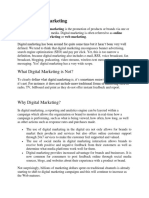Module 3
Uploaded by
Fuji DemosModule 3
Uploaded by
Fuji DemosTHE MANUAL
TWOWAYDIGITALMEDIA
OFFICIAL TRAINING MANUAL
© All rights reserved. Two-Way Digital Media 2021
Volume 1
PRODUCT AND SERVICES TRAINING
When we think of product and services training, we generally mean product awareness training, which includes
teaching trainees and employees about a company's products or services. Product and services knowledge allow
trainees or employees to connect efficiently and enthusiastically with consumers, cultivating faith and
confidence in their relationships. It also means they can respond to questions quickly and deal with common
customer objections.
Currently we focus on the following key skills;
LOGO AND BRANDING
WEB DESIGN AND DEVELOPMENT
SOCIAL MEDIA MANAGEMENT
CONTENT CREATION THIS ENSURES THAT
EMPLOYEE'S
SOFTWARE DEVELOPMENT CAN COMMUNICATE
EFFECTIVELY AND
ENTHUSIASTICALLY,
BUILDING TRUST AND
CONFIDENCE IN
CUSTOMER
RELATIONSHIPS.
OFFICIAL TRAINING MANUAL
© All rights reserved. Two-Way Digital Media 2021
Volume 1
logo and branding
A logo by itself is a graphic element that represents the brand, while a brand is a combination of all
tangible and intangible aspects that represent the organization. Without the brand, the logo wouldn’t
have a real meaning, it would be simply a graphical element.
A logo is a single symbol that a customer can associate with your company first and foremost. Your company's,
industry's, and target audience's identities and values should all be expressed in your logo. If you don't want to go
overboard, the logo should be iconic enough to make an impact, but not so complex that viewers will forget about
it in the constant bombardment of images they consume online.
Branding is the process of building a brand. To be more specific, it is a strategy designed by companies to help
people to quickly identify their products and organization, and give them a reason to choose their products over
the competition. A branding strategy clarifies what a particular brand is and is not. Branding can be done through
the use of different tools.
When combined, a well-designed logo and an effective branding strategy help
organizations reach their audiences in an effective way, but also create a resilient,
industry-leading brand. If you are an entrepreneur and looking into building a new
BRAND
brand, don’t underestimate the importance of a well-designed logo, aligned to your
overall branding strategy. It will be a rewarding investment for your brand and PERCEIVED
organization in the long term. IMAGES AS A
WHOLE
LOGO
IDENTIFIES YOUR
BUSINESS
OFFICIAL TRAINING MANUAL
© All rights reserved. Two-Way Digital Media 2021
Volume 1
WEB DESIGN AND DEVELOPMENT
The creation of websites that are viewed on the internet is referred to as web design. A web
designer is responsible for a website's appearance, layout, and, in certain cases, content. On
the other hand, web developers create the design and functionality of a website using web
languages and software tools.
A web designer's primary duties include the following:
Using applications such as Adobe Photoshop, Framer, or Sketch to create the website's final layout design
Graphic design and logo design are two skills that you should have.
Have a clear sense of user experience to find the best way to perform the desired purpose.
This includes the website's layout, buttons, photos, and overall format.
Web designers must stay up to date with the most recent design trends.
It's also critical to maintaining the design continuity that has become commonplace thanks to companies like Google
and Facebook.
Since the user's eyes are already familiar with the website environment and interface, it is easier to access and use.
In addition to the website's branding, color palettes, typography, and readability, web designers must consider the
website's branding, color palettes, and typography.
The following are some of the most important duties of a web developer:
Creating the user interface that allows a user to communicate with the website.
Front-end developers built this user interface using HTML, CSS, and JS.
To speed up the development process, front-end developers can use styling
preprocessors, javascript libraries, and frameworks (see my previous article).
Front-end developers offer back-end developers the markup template so they can
A SUCCESSFUL
create a complex website and send all of the necessary data to the server and WEB DESIGN IS
databases.
Back-end developers use languages like PHP and MySQL to create the website's
AESTHETICALLY
backbone. The same development environments or IDEs can be used by front-end and APPEALING AND
back-end developers (Integrated Development Environment). These are software
application tools that allow you to code and construct the website's structure.
SUITABLE FOR
Versioning software can also be used by web developers to keep track of previous THE WEBSITE'S
builds. This will allow them to easily and quickly revert to a previous “unbroken” version BRAND
if necessary.
OFFICIAL TRAINING MANUAL
© All rights reserved. Two-Way Digital Media 2021
Volume 1
social media management
The process of assessing social media users and designing a plan targeted to them, creating and
sharing content for social media accounts, tracking online interactions, partnering with influencers,
delivering community service, and monitoring, evaluating, and reporting on social media performance
and ROI are all examples of social media management.
Importance of Social Media Management
In order to boost brand awareness, improve Marketing efforts and raise sales, Social Media
Manager are responsible for planning, implementing, managing and monitoring company’s
Social Media strategy. They help their companies capitalize on the swell popularity of social
media platforms by creating and overseeing engagement, branding and marketing campaigns.
Social Media Management's Role
Social Media Management is essential for business, given
the high probability of people who encounter current brands HOW CAN YOU GET
and become devoted to them through any social media A THOROUGH
platforms or any electronics platforms. A social Media
UNDERSTANDING OF
Manager creates the most value in order to some
businesses distribute their social media activities YOUR SOCIAL MEDIA
throughout several departments. AUDIENCE?
BEGIN BY
CATEGORIZING
OFFICIAL TRAINING MANUAL
© All rights reserved. Two-Way Digital Media 2021
Volume 1
content creation
Is the contribution of knowledge to any medium, especially digital media, for a specific end-user/audience in a
specific context. For self-expression, distribution, marketing, and/or publication, content is described as
anything that is to be conveyed through some medium, such as voice, writing, or any of various arts. Maintaining
and upgrading blogs, blogging, essay writing, photography, videography, online commentary, maintaining social
media pages, and editing and distributing digital media are all examples of content creation.
Phase in Creating Content
Brainstorming
Content ideas can come from a variety of sources, including your content team, clients, other
stakeholders in your organization, new data, or something that inspires you. And, depending on
the goal of the piece of material, evaluating the best approach to a particular subject can be
difficult.
Planning
The first step in planning your piece of content is to evaluate the format in which you want
it to appear. Some concepts would be more powerful if they are visually illustrated, which
may necessitate the creation of an infographic or video. Plaintext may be the best option
for some material. A blog post, essay, or eBook might be the best format for them.
Investigate which types of content have already been generated around your subject to gain
a lot of insight.
CONTENT
Creating CREATION
It's finally time to start working on your stuff. You're already a pro at this REFERS TO "THE
part. Make use of the plans you've created and the brainstorming you've
done to create a fantastic final product. However, bear in mind that MATERIAL
content creation is a living, breathing process when you compose, film, PEOPLE ADD TO
design, or create. Don't be afraid to take a step back if you find something
is wrong with the perspective you chose or the content format you chose. THE ONLINE
WORLD."
OFFICIAL TRAINING MANUAL
© All rights reserved. Two-Way Digital Media 2021
Volume 1
software development
Is the method of developing and maintaining programs, frameworks, and other software components through
conceiving, specifying, designing, programming, logging, checking, and bug fixing. Software development is the
process of writing and preserving source code, but it often encompasses all that happens between the
conception of a desired piece of software and its final manifestation, often in a prepared and organized
manner.
STAGES OF SOFTWARE DEVELOPMENT
Analyzing the problem
Market research
Gathering requirements for the proposed software
Devising a plan or design for the software
Implementation (coding) of the software
Testing the software SOFTWARE THAT
Deployment
Maintenance and bug fixing
YOU CAN USE
SYSTEM
SOFTWARE
The software development life-cycle, or SDLC, is a term that refers to
all of these phases. Various approaches to software development
can conduct these stages in a different order or devote more or less APPLICATION
time to each stage. At each point of software development, the level SOFTWARE
of detail in the documentation generated varies.
PROGRAMMING
LANGUAGES
OFFICIAL TRAINING MANUAL
© All rights reserved. Two-Way Digital Media 2021
Volume 1
You might also like
- Creating Connections A Systems Thinking Approach To Content CreationNo ratings yetCreating Connections A Systems Thinking Approach To Content Creation44 pages
- Content Creator_ How to Stand Out Amongst the NoiseNo ratings yetContent Creator_ How to Stand Out Amongst the Noise106 pages
- Digital Content Creation for Content Creators Course BrochureNo ratings yetDigital Content Creation for Content Creators Course Brochure14 pages
- Introduction To Internet, HTML & CSS WEB DEVNo ratings yetIntroduction To Internet, HTML & CSS WEB DEV94 pages
- Digital Branding Fever 1st Edition Nasos Poulis - Download the entire ebook instantly and explore every detailNo ratings yetDigital Branding Fever 1st Edition Nasos Poulis - Download the entire ebook instantly and explore every detail68 pages
- (Laurence King) Alan Pipes - How To Design Websites-Laurence King Publishing (2011)No ratings yet(Laurence King) Alan Pipes - How To Design Websites-Laurence King Publishing (2011)172 pages
- Social Media Marketing Workbook 2019 How To Leverage The Power of Facebook Advertising, Instagram Marketing, YouTube and SEO To Explode Your Business and PersoNo ratings yetSocial Media Marketing Workbook 2019 How To Leverage The Power of Facebook Advertising, Instagram Marketing, YouTube and SEO To Explode Your Business and Perso127 pages
- (2022) Modul 2-Digital Strategy Campaign Objectives-Website Development-EnglishNo ratings yet(2022) Modul 2-Digital Strategy Campaign Objectives-Website Development-English58 pages
- Digital Branding Fever 1st Edition Nasos Poulis 2024 scribd download100% (2)Digital Branding Fever 1st Edition Nasos Poulis 2024 scribd download55 pages
- Master in Creative Direction Content and BrandingNo ratings yetMaster in Creative Direction Content and Branding38 pages
- Design Our Job I I: Education Program ManualNo ratings yetDesign Our Job I I: Education Program Manual20 pages
- A Starter Guide To Digital Products (@annesolutionsph)No ratings yetA Starter Guide To Digital Products (@annesolutionsph)21 pages
- The Importance of Website Usability in Digital Marketing a Review PDFNo ratings yetThe Importance of Website Usability in Digital Marketing a Review PDF10 pages
- Democratizing No-Code Application Development with Bubble: A beginner's guide to rapidly building applications with powerful features of Bubble without codeFrom EverandDemocratizing No-Code Application Development with Bubble: A beginner's guide to rapidly building applications with powerful features of Bubble without codeNo ratings yet
- Adapting Software Development for Innovation and EfficiencyFrom EverandAdapting Software Development for Innovation and EfficiencyNo ratings yet
- Strategic Branding: Creating a Memorable and Impactful Business IdentityFrom EverandStrategic Branding: Creating a Memorable and Impactful Business IdentityNo ratings yet
- Hands-on Site Reliability Engineering: Build Capability to Design, Deploy, Monitor, and Sustain Enterprise Software Systems at Scale (English Edition)From EverandHands-on Site Reliability Engineering: Build Capability to Design, Deploy, Monitor, and Sustain Enterprise Software Systems at Scale (English Edition)No ratings yet
- Strategic Leadership in Responsive Web Design: A tech leader's guide to achieving business excellence by adopting responsive web designFrom EverandStrategic Leadership in Responsive Web Design: A tech leader's guide to achieving business excellence by adopting responsive web designNo ratings yet
- Optimizing The Vehicle Routing Problem With Time Windows: A Discrete Particle Swarm Optimization ApproachNo ratings yetOptimizing The Vehicle Routing Problem With Time Windows: A Discrete Particle Swarm Optimization Approach14 pages
- AOS Assignment 1: Features of Operating System (OS)No ratings yetAOS Assignment 1: Features of Operating System (OS)3 pages
- Unit 3: Snmpv1 Network Management - Organization & Information ModelsNo ratings yetUnit 3: Snmpv1 Network Management - Organization & Information Models3 pages
- ROS Node for Publishing YAW Data from MPU6050 SensorNo ratings yetROS Node for Publishing YAW Data from MPU6050 Sensor3 pages
- Cyberviser Company Profile With Logo VersionNo ratings yetCyberviser Company Profile With Logo Version4 pages
- CurrentUse - SB Founder Master Table11No ratings yetCurrentUse - SB Founder Master Table113,052 pages
- U6 - M2 - L6 - Microservice Architecture - Benefits and Drawbacks - Annotated - TaggedNo ratings yetU6 - M2 - L6 - Microservice Architecture - Benefits and Drawbacks - Annotated - Tagged13 pages
- College of Information and Communication Engineering: Modern Signal ProcessingNo ratings yetCollege of Information and Communication Engineering: Modern Signal Processing9 pages
- MediHub Version 3 User Guide For 1st Time Login and Subsequent Login - 21 Aug 2019 Effective 1 Sep 2019No ratings yetMediHub Version 3 User Guide For 1st Time Login and Subsequent Login - 21 Aug 2019 Effective 1 Sep 201916 pages
- Digital Literacy and Cyberbullying Behav 5ef9de18No ratings yetDigital Literacy and Cyberbullying Behav 5ef9de1824 pages
- Network Algorithmics: An Interdisciplinary Approach To Designing Fast Networked Devices George Varghese & Jun XuNo ratings yetNetwork Algorithmics: An Interdisciplinary Approach To Designing Fast Networked Devices George Varghese & Jun Xu49 pages
- SEDCO Kiosk Solution Customer Visit ManagementNo ratings yetSEDCO Kiosk Solution Customer Visit Management2 pages
- Creating Connections A Systems Thinking Approach To Content CreationCreating Connections A Systems Thinking Approach To Content Creation
- Content Creator_ How to Stand Out Amongst the NoiseContent Creator_ How to Stand Out Amongst the Noise
- Digital Content Creation for Content Creators Course BrochureDigital Content Creation for Content Creators Course Brochure
- Digital Branding Fever 1st Edition Nasos Poulis - Download the entire ebook instantly and explore every detailDigital Branding Fever 1st Edition Nasos Poulis - Download the entire ebook instantly and explore every detail
- (Laurence King) Alan Pipes - How To Design Websites-Laurence King Publishing (2011)(Laurence King) Alan Pipes - How To Design Websites-Laurence King Publishing (2011)
- Social Media Marketing Workbook 2019 How To Leverage The Power of Facebook Advertising, Instagram Marketing, YouTube and SEO To Explode Your Business and PersoSocial Media Marketing Workbook 2019 How To Leverage The Power of Facebook Advertising, Instagram Marketing, YouTube and SEO To Explode Your Business and Perso
- (2022) Modul 2-Digital Strategy Campaign Objectives-Website Development-English(2022) Modul 2-Digital Strategy Campaign Objectives-Website Development-English
- Digital Branding Fever 1st Edition Nasos Poulis 2024 scribd downloadDigital Branding Fever 1st Edition Nasos Poulis 2024 scribd download
- Designer vs. Developer - Which Career Pays More and Fits You Best ?From EverandDesigner vs. Developer - Which Career Pays More and Fits You Best ?
- A Starter Guide To Digital Products (@annesolutionsph)A Starter Guide To Digital Products (@annesolutionsph)
- The Importance of Website Usability in Digital Marketing a Review PDFThe Importance of Website Usability in Digital Marketing a Review PDF
- The Creative Grid a Guide to Graphic Design PrinciplesFrom EverandThe Creative Grid a Guide to Graphic Design Principles
- Corporate Communications Simplified - A HandbookFrom EverandCorporate Communications Simplified - A Handbook
- Essential Tools & Skills for Virtual AssistantsFrom EverandEssential Tools & Skills for Virtual Assistants
- Democratizing No-Code Application Development with Bubble: A beginner's guide to rapidly building applications with powerful features of Bubble without codeFrom EverandDemocratizing No-Code Application Development with Bubble: A beginner's guide to rapidly building applications with powerful features of Bubble without code
- Adapting Software Development for Innovation and EfficiencyFrom EverandAdapting Software Development for Innovation and Efficiency
- Strategic Branding: Creating a Memorable and Impactful Business IdentityFrom EverandStrategic Branding: Creating a Memorable and Impactful Business Identity
- Hands-on Site Reliability Engineering: Build Capability to Design, Deploy, Monitor, and Sustain Enterprise Software Systems at Scale (English Edition)From EverandHands-on Site Reliability Engineering: Build Capability to Design, Deploy, Monitor, and Sustain Enterprise Software Systems at Scale (English Edition)
- Unleashing Social Media Marketing StrategiesFrom EverandUnleashing Social Media Marketing Strategies
- Strategic Leadership in Responsive Web Design: A tech leader's guide to achieving business excellence by adopting responsive web designFrom EverandStrategic Leadership in Responsive Web Design: A tech leader's guide to achieving business excellence by adopting responsive web design
- Optimizing The Vehicle Routing Problem With Time Windows: A Discrete Particle Swarm Optimization ApproachOptimizing The Vehicle Routing Problem With Time Windows: A Discrete Particle Swarm Optimization Approach
- AOS Assignment 1: Features of Operating System (OS)AOS Assignment 1: Features of Operating System (OS)
- Unit 3: Snmpv1 Network Management - Organization & Information ModelsUnit 3: Snmpv1 Network Management - Organization & Information Models
- ROS Node for Publishing YAW Data from MPU6050 SensorROS Node for Publishing YAW Data from MPU6050 Sensor
- U6 - M2 - L6 - Microservice Architecture - Benefits and Drawbacks - Annotated - TaggedU6 - M2 - L6 - Microservice Architecture - Benefits and Drawbacks - Annotated - Tagged
- College of Information and Communication Engineering: Modern Signal ProcessingCollege of Information and Communication Engineering: Modern Signal Processing
- MediHub Version 3 User Guide For 1st Time Login and Subsequent Login - 21 Aug 2019 Effective 1 Sep 2019MediHub Version 3 User Guide For 1st Time Login and Subsequent Login - 21 Aug 2019 Effective 1 Sep 2019
- Network Algorithmics: An Interdisciplinary Approach To Designing Fast Networked Devices George Varghese & Jun XuNetwork Algorithmics: An Interdisciplinary Approach To Designing Fast Networked Devices George Varghese & Jun Xu

























































































